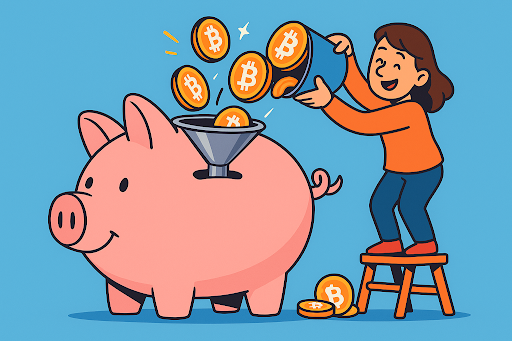Lyn Alden just dropped a 2-hour masterclass with Tom Bilyeu to his 4.5M+ subscribers.
If you don’t understand what’s happening to money right now, you’ll wake up on the wrong side of history.
Here are 10 insights on where the system is breaking—and what comes next. 🧵👇

If you don’t understand what’s happening to money right now, you’ll wake up on the wrong side of history.
Here are 10 insights on where the system is breaking—and what comes next. 🧵👇


1. Fiscal Dominance: The Train With No Brakes
The Fed once cooled inflation by hiking rates. That era is over.
Deficits now dwarf private credit creation, so higher rates blow out interest costs.
This is fiscal dominance—no brakes, and debasement becomes policy.
The Fed once cooled inflation by hiking rates. That era is over.
Deficits now dwarf private credit creation, so higher rates blow out interest costs.
This is fiscal dominance—no brakes, and debasement becomes policy.
2. The Hollowing of the Middle Class
Inflation isn’t natural—it’s engineered. To survive, you must own assets.
Half climb, half sink. Housing once protected the middle class, but prices and rates now lock them out.
The fiat boil is here.
Inflation isn’t natural—it’s engineered. To survive, you must own assets.
Half climb, half sink. Housing once protected the middle class, but prices and rates now lock them out.
The fiat boil is here.
3. When Debt Tops Defense, Empires Wobble
U.S. interest expense just surpassed military spending.
At ~122% debt-to-GDP and drifting toward the 130% “red line,” the spiral accelerates.
History says when debt service outruns defense, decline has begun.
U.S. interest expense just surpassed military spending.
At ~122% debt-to-GDP and drifting toward the 130% “red line,” the spiral accelerates.
History says when debt service outruns defense, decline has begun.
4. Weak Money Breeds Unrest
When money breaks, nations don’t just go broke—they turn on themselves.
Inequality breeds rage: some get grapes, others cucumbers for the same effort.
The bigger risk isn’t invasion; it’s internal revolt.
When money breaks, nations don’t just go broke—they turn on themselves.
Inequality breeds rage: some get grapes, others cucumbers for the same effort.
The bigger risk isn’t invasion; it’s internal revolt.
5. Trade Deficits Hollow Nations
Reserve-currency privilege forces persistent U.S. trade deficits.
Dollars flow out, then flood back to buy stocks and real estate.
Coastal hubs boom; the heartland hollows. Capital concentrates while workers are left behind.
Reserve-currency privilege forces persistent U.S. trade deficits.
Dollars flow out, then flood back to buy stocks and real estate.
Coastal hubs boom; the heartland hollows. Capital concentrates while workers are left behind.
6. Entitlements = The Fiscal Time Bomb
The real deficit isn’t “waste.” It’s Social Security, Medicare, and healthcare.
By the 2030s, the trust fund runs dry—implying ~25% cuts without reform.
Reform is untouchable; math wins. Inflation fills the gap.
The real deficit isn’t “waste.” It’s Social Security, Medicare, and healthcare.
By the 2030s, the trust fund runs dry—implying ~25% cuts without reform.
Reform is untouchable; math wins. Inflation fills the gap.
7. Nothing Stops This Train
Default rarely arrives in one crash. It’s rolling mini-crises, soft defaults, and a historic bond drawdown.
Expect years of debasement that eats savings and fuels populism.
Empires unravel slowly—until suddenly they don’t.
Default rarely arrives in one crash. It’s rolling mini-crises, soft defaults, and a historic bond drawdown.
Expect years of debasement that eats savings and fuels populism.
Empires unravel slowly—until suddenly they don’t.
8. Neutral Assets Are the Escape Valve
The world is diversifying out of Treasuries.
Central banks add gold; some sovereigns test Bitcoin.
The next reserve regime won’t crown a new fiat—it shifts toward neutral assets. Gold is the old rail; Bitcoin is the new standard.
The world is diversifying out of Treasuries.
Central banks add gold; some sovereigns test Bitcoin.
The next reserve regime won’t crown a new fiat—it shifts toward neutral assets. Gold is the old rail; Bitcoin is the new standard.
9. Bitcoin Is a Protocol, Not Just an Asset
Bitcoin solved a 150-year problem: fast settlement.
Value can move globally without trusting a central ledger.
Not just digital gold—it’s a base layer like TCP/IP. Protocols become foundations.
Bitcoin solved a 150-year problem: fast settlement.
Value can move globally without trusting a central ledger.
Not just digital gold—it’s a base layer like TCP/IP. Protocols become foundations.
10. Zero Is the Wrong Allocation
Lyn’s advice is blunt: zero Bitcoin is the wrong number.
Even a small allocation gives skin in the game, protection from dilution, and exposure to the hardest money we’ve ever seen.
Owning none is the bigger risk.
Lyn’s advice is blunt: zero Bitcoin is the wrong number.
Even a small allocation gives skin in the game, protection from dilution, and exposure to the hardest money we’ve ever seen.
Owning none is the bigger risk.
Closer
That’s 10 takeaways from Lyn Alden on Impact Theory.
A 2-hour macro deep dive, compressed for signal.
Which insight hit hardest for you?
Watch the full conversation here:
That’s 10 takeaways from Lyn Alden on Impact Theory.
A 2-hour macro deep dive, compressed for signal.
Which insight hit hardest for you?
Watch the full conversation here:
If you’re a high-net-worth family, individual, or business looking to build a serious Bitcoin position, Swan Private is the concierge service trusted by the world’s leading allocators.
Let's chat.
swanbitcoin.com/private?utm_ca…
Let's chat.
swanbitcoin.com/private?utm_ca…
• • •
Missing some Tweet in this thread? You can try to
force a refresh















